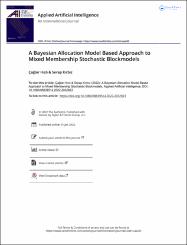Please use this identifier to cite or link to this item:
https://hdl.handle.net/20.500.11779/1747Full metadata record
| DC Field | Value | Language |
|---|---|---|
| dc.contributor.author | Kırbız, Serap | - |
| dc.contributor.author | Hızlı, Çağlar | - |
| dc.date.accessioned | 2022-03-02T12:46:26Z | |
| dc.date.available | 2022-03-02T12:46:26Z | |
| dc.date.issued | 2022 | - |
| dc.identifier.citation | Hızlı, Ç., & Kırbız, S. (January 2022). A Bayesian Allocation Model Based Approach to Mixed Membership Stochastic Blockmodels. Applied Artificial Intelligence, pp 1-23. DOI : https://doi.org/10.1080/08839514.2022.2032923 | en_US |
| dc.identifier.issn | 1087-6545 | - |
| dc.identifier.issn | 0883-9514 | - |
| dc.identifier.uri | https://doi.org/10.1080/08839514.2022.2032923 | - |
| dc.identifier.uri | https://hdl.handle.net/20.500.11779/1747 | - |
| dc.description.abstract | Although detecting communities in networks has attracted considerable recent attention, estimating the number of communities is still an open problem. In this paper, we propose a model, which replicates the generative process of the mixed-membership stochastic block model (MMSB) within the generic allocation framework of Bayesian allocation model (BAM) and BAM-MMSB. In contrast to traditional blockmodels, BAM-MMSB considers the observations as Poisson counts generated by a base Poisson process and marks according to the generative process of MMSB. Moreover, the optimal number of communities for BAM-MMSB is estimated by computing the variational approximations of the marginal likelihood for each model order. Experiments on synthetic and real data sets show that the proposed approach promises a generalized model selection solution that can choose not only the model size but also the most appropriate decomposition. | en_US |
| dc.language.iso | en | en_US |
| dc.publisher | Taylor and Francis Ltd. | en_US |
| dc.rights | info:eu-repo/semantics/openAccess | en_US |
| dc.subject | Community | en_US |
| dc.subject | Inference | en_US |
| dc.title | A Bayesian Allocation Model Based Approach To Mixed Membership Stochastic Blockmodels | en_US |
| dc.type | Article | en_US |
| dc.identifier.doi | 10.1080/08839514.2022.2032923 | - |
| dc.identifier.scopus | 2-s2.0-85124183409 | - |
| dc.authorid | Serap Kırbız / 0000-0001-7718-3683 | - |
| dc.description.woscitationindex | Science Citation Index Expanded | en_US |
| dc.identifier.wosquality | Q2 | - |
| dc.description.WoSDocumentType | Article; Early Access | - |
| dc.description.WoSInternationalCollaboration | Uluslararası işbirliği ile yapılmayan - HAYIR | en_US |
| dc.description.WoSPublishedMonth | Şubat | en_US |
| dc.description.WoSIndexDate | 2022 | en_US |
| dc.description.WoSYOKperiod | YÖK - 2021-22 | en_US |
| dc.identifier.scopusquality | Q2 | - |
| dc.relation.publicationcategory | Makale - Uluslararası Hakemli Dergi - Kurum Öğretim Elemanı | en_US |
| dc.identifier.endpage | 23 | en_US |
| dc.identifier.startpage | 1 | en_US |
| dc.department | Mühendislik Fakültesi, Elektrik Elektronik Mühendisliği Bölümü | en_US |
| dc.relation.journal | Applied Artificial Intelligence | en_US |
| dc.identifier.wos | WOS:000750893600001 | - |
| dc.institutionauthor | Kırbız, Serap | - |
| item.grantfulltext | open | - |
| item.languageiso639-1 | en | - |
| item.openairetype | Article | - |
| item.cerifentitytype | Publications | - |
| item.fulltext | With Fulltext | - |
| item.openairecristype | http://purl.org/coar/resource_type/c_18cf | - |
| crisitem.author.dept | 02.05. Department of Electrical and Electronics Engineering | - |
| Appears in Collections: | Elektrik Elektronik Mühendisliği Bölümü Koleksiyonu Scopus İndeksli Yayınlar Koleksiyonu / Scopus Indexed Publications Collection WoS İndeksli Yayınlar Koleksiyonu / WoS Indexed Publications Collection | |
Files in This Item:
| File | Description | Size | Format | |
|---|---|---|---|---|
| 08839514.2022.pdf | Full Text - Article | 3.61 MB | Adobe PDF |  View/Open |
CORE Recommender
Sorry the service is unavailable at the moment. Please try again later.
Items in GCRIS Repository are protected by copyright, with all rights reserved, unless otherwise indicated.